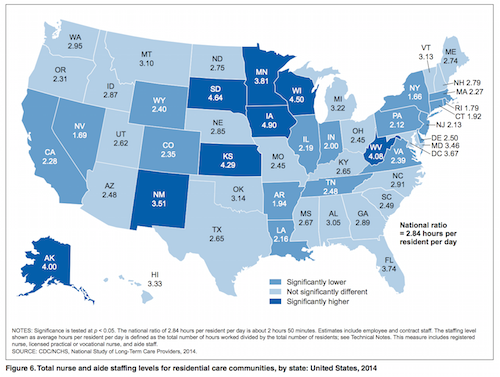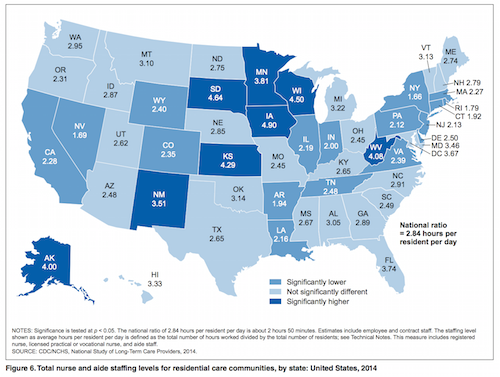
Total nurse and aide staffing levels for assisted living and similar residential care communities are significantly higher than the national ratio of 2.84 hours per resident per day in eight states, according to a new report (PDF) issued Feb. 19 by the National Center for Health Statistics, part of the Centers for Disease Control and Prevention.
Those states: Iowa (4.90 hours per resident per day), South Dakota (4.64), Wisconsin (4.50), Kansas (4.29), West Virginia (4.08), Alaska (4.00) Minnesota (3.81) and New Mexico (3.51).
Overall nurse and aide staffing levels in residential care communities, according to the report, are significantly lower than the national ratio in 17 states: Delaware (2.50), Tennessee (2.48), Wyoming (2.40), Virginia (2.39), Colorado (2.35), California (2.28), Massachusetts (2.27), Illinois (2.19), Louisiana (2.16), New Jersey (2.13), Pennsylvania (2.12), Indiana (2.00), Arkansas (1.94), Connecticut (1.92), Rhode Island (1.79), Nevada (1.69) and New York (1.66)
Data were taken from the residential care component of the 2014 wave of the center’s biennial National Study of Long-Term Care Providers. The average hours per resident per day is defined as the total number of hours worked divided by the total number of residents and does not necessarily reflect the amount of care given to a particular resident, according to the report.
When the report’s 2014 data related to staffing for registered nurses, licensed practical nurses or vocational nurses, and aides are examined individually by position, however, Kansas, South Dakota and West Virginia are the only three states where staffing levels for all positions are significantly higher than the national ratios. Louisiana, Nevada and Rhode Island are the only three states where staffing levels for all positions are significantly lower than the national ratios
Specifically, the nine states in which RN staffing in residential care communities is significantly higher than the national ratio of 0.27 hours per resident per day include South Dakota (1.03), Iowa (0.99), Hawaii and Maryland (0.59 each), Kansas and West Virginia (0.42 each), Minnesota (0.40), Vermont (0.36) and Wyoming (0.34). In Washington, D.C., the ratio is 0.40, also higher than the national ratio.
RN staffing in residential care communities is significantly lower than the national ratio in 13 states: Delaware (0.21), Rhode Island and Mississippi (0.19 each), Alabama and California (0.18 each), Virginia (0.16), Arkansas (0.15), New York (0.13), Tennessee (0.12), Pennsylvania (0.10), Colorado (0.09), Nevada (0.07) and Louisiana (0.04),
The 19 states in which LPNs or vocational nurse staffing in residential care communities is significantly higher than the national ratio of 0.20 hours per resident per day include Iowa (1.26), Ohio (0.63), Indiana (0.61), Kansas (0.53), Delaware and South Dakota (0.51 each), Tennessee (0.45), Mississippi and West Virginia (0.44 each), Kentucky (0.43), Alabama (0.42), Pennsylvania (0.38), New Hampshire (0.37), Illinois (0.34), New Jersey and Oklahoma (0.32 each), North Dakota (0.31) and Nebraska and Virginia (0.29 each).
LPN and vocational nurse staffing is significantly lower than the national ratio in 11 states: Rhode Island (0.13), Colorado (0.12), Connecticut and Idaho (0.11 each), Maine and New Mexico (0.09 each), California (0.08), Alaska and Louisiana (0.07 each), Utah (0.03), Nevada (0.02).
The seven states in which aide staffing in residential care communities is significantly higher than the national ratio of 2.37 hours per resident per day include Wisconsin (3.94), Alaska (3.62), Kansas (3.35), West Virginia (3.22), Minnesota (3.21), New Mexico (3.14) and South Dakota (3.09).
Aide staffing levels are significantly lower than the national ratio in 21 states: North Dakota (2.13), Louisiana and Mississippi (2.05 each), Missouri (1.99), Kentucky and Virginia (1.94 each), Tennessee (1.91), Wyoming (1.83), Massachusetts and Oregon (1.82 each), Delaware (1.78), Pennsylvania (1.64), Illinois and Ohio (1.61 each), Nevada and New Jersey (1.59 each), Arkansas (1.57), Rhode Island (1.46), Connecticut (1.41), New York (1.27) and Indiana (1.18).
The report also details staffing levels based on number of beds, geographic locale, ownership status, staff type and resident composition.
The figure below shows total nurse and aide staffing levels for assisted living and similar residential care communities.




